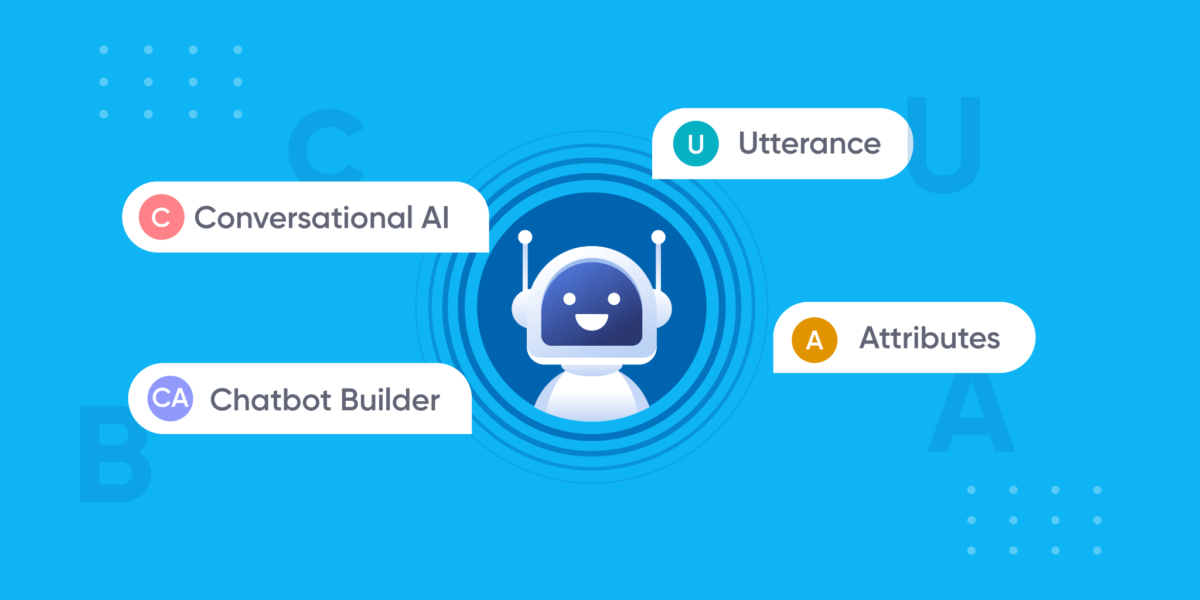The ABC’s of a Chatbot – with Examples

The ABC’s of a Chatbot – with Examples
Chatbots are declared to be the ongoing fad to survive in this business world, where automation is the key to several actions. Multiple elements and layers account for the proper functioning of a chatbot. However, chatbot vocabulary and Conversational AI can get complicated. So it is recommended to be aware of such jargon to understand a chatbot’s intricacies. This entire blog piece is simplified into understandable language. It contains examples for better clarity to cater to people ailing from a non-chatbot industry, as too much knowledge never hurts anyone.
So, here are a few trending terms from the chatbot vocabulary covered in this blog:
- AI
- AI accuracy
- Algorithm
- Attributes
- Chatbots
- Chatbot builder
- Chat widget
- Conversational channel
- Conversational UI
- Conversational UX
- Deep learning
- Entity
- Human intervention
- Integrations
- Intents
- Intelligent routing
- Machine learning
- NLP, NLU, NLG
- Quick replies
- Sentiment analysis
- Training data
- Utterance
- Use-case
- Voicebots
- Webhooks
AI
AI or artificial intelligence is intelligence demonstrated by machines. Wherein, the machines are imbibed with human qualities to function and process. We have all laid our hands-on Siri, Alexa or Cortana.
The ability to derive search results with just speaking and not typing it out is through the presence of AI. Or even how Netflix accurately suggests the TV shows that you might like watching on a lazy Sunday.
The same level of intelligence is used as a base to process chatbots and allow millions of individuals to converse with a human-like chatbot.
AI accuracy
Like humans, AI can make errors, too. Fortunately, the accuracy of any machine-learning algorithm is determined by a well-defined metric system. The proportion of how accurately an AI has predicted data points among all the data points is known as AI Accuracy.
A example of AI Accuracy measure is a test in which a system is asked to detect, categorise, and recognise cars and/or trees in an image.
Algorithm
An algorithm is basically a set of instructions for completing a task and/or solving a problem. A recipe or blueprint is a typical analogy for describing an algorithm.
Algorithms are used by every computerised device to perform several functions.
A classic example of an algorithm can be a social media platform like Youtube’s method of bringing video content and advertisements to its viewers’ notice based on their viewing history, likes and dislikes, and choices.
Attributes
Attributes are essential pieces of information that a chatbot or voice bot collects during its conversation with the user, like names, email addresses, phone numbers, and more!
Bot: What’s your name?
User: Raj.
Bot: Thank you! How can I assist you today, Raj?
Input Sentence:
What’s the best skincare routine for summer?
Words Score:
Best ( Class- Skincare)
Skincare (Class- Skincare)
Routine (Class- Skincare)
Summer (No match)
Thus, the Total score is 3. The input sentence gets classified under the class “Skincare”. Assuming that’s highest after being compared to other courses.
Furthermore, the bot checks for common words between the input and class sentences. Whichever class gets the maximum score based on commonality, the input sentence is classified under that section.
Chatbots
Chatbots, as the name of this blog suggests, are the key features that will revolutionise automation, customer support and Conversational AI.
They are automated systems that run over the internet. A chatbot allows people to automate several tasks and extend various activities towards the bot to take over.
Chatbot builder
Chatbot builders are tools that help one build a functional chatbot. Usually, chatbot builders are platforms or businesses that help other businesses automate and streamline their communication channels with their customers.
In today’s market, there are different types of chatbot builders, such as ready-made chatbot solutions, self-service chatbot builders that help a business design their chatbots according to their requirements, and chatbots built from scratch that cater to a specific company’s needs.
Chat widget
A chat widget is a small chat icon that appears on a website or app, allowing customers to have a conversation and hear their requirements for a product or service. Chat widgets can track user activity on the platform and also come to the rescue when a customer is having an issue accessing the website or app.
Moreover, chat widgets are managed by chatbots and live agents. However, chatbots are turning out to be the favourite in this case, which is purely a result of faster responses and more satisfied customers.
Conversational channel
A conversational channel is a medium or an interface that allows a one-on-one conversation between a user and a sender (bot or live agent) on a platform.
This channel can be users of a chat implementation who are typically accustomed to a channel, such as WhatsApp or Messenger.
Learn which channel is best for you here: Instagram vs Facebook vs WhatsApp
Conversational UI
This refers to the user interface, which enables the user to interact with the bot. It is defined by the design of the chatbot, the widget, the button used, the bot’s colour and various other things.
It’s the way the user interacts with the chatbot. Thus, including everything that comprises that process—from replying to the bot’s question, selecting a button/image, visiting a link, etc.
Conversational UX
This refers to user experience, which includes the entire experience that the user has while conversing with the chatbot. Thus it would consist of-
- Speed in giving responses.
- Quality of the responses given.
- Being user-friendly.
Among various other parameters.
Deep learning
The end goal of implementing a chatbot is to minimise human interaction as much as possible. The chatbot is taught to get accustomed to multiple scenarios through deep learning. Furthermore, provide accurate responses.
Thus, gradually, the chatbot will be able to phase out human intervention. As every query it processes, it becomes much more intelligent. With deep learning, the chatbot is created using machine learning algorithms. So, more data will always be helpful in this case.
Entity
Entities are specific terms that provide relevance to your intents. These are words picked up from the user intent (user intention). Thus allowing the bot to fetch the response related to those entities.
For example, the user says – “What’s today’s weather like? ”
The user’s intent here is to get a response stating how the weather will be throughout the day.
Machine Learning is the process of equipping computers to learn with experience. Thus, with every query, the chatbot gets programmed with new information and answers the question with much more expertise when framed again.
Human intervention
Chatbots are not entirely superhuman. They can’t handle precise questions. It might happen in the future, given the constant rise in technology.
Thus, through seamless hand-offs, an agent can pick up from where the chatbot left off and continue the conversation.
Intent
Intent refers to the purpose of the user’s input. It’s the reason why the user typed in the query. As the name suggests, it’s the user’s intention.
For example, the user says – “What’s today’s weather like? ”
The user’s intent here is to get a response stating how the weather will be throughout the day.
Integrations
Integration means combining a particular software with multiple others to create a unified experience. The significant advantage that comes out of this merger is that it improves accessibility for the user as it allows multiple programs to co-exist on a single database.
For example, resolving a customer query about their order status can be simple and quick if the customer profile includes information collected by the chatbot, such as their phone number or email address.
Intelligent routing
Intelligent routing (IR), alternatively known as skills-based routing, is used by call centres to manage customer queries that come from the mail, messages or other conversation channels. The centre gathers all the required information and then transfers them to the right agent who can step in and resolve the issue for the customer in the first go.
Additionally, IR is vital to resolve customer queries and elevate customer experience, as it exponentially decreases the time a customer is put on hold.
Machine learning
Virtual assistants such as Cortana, Alexa, etc., come in handy to set alarms, retrieve data, and play music by requesting the virtual assistant.
However, these assistants fail to be well-equipped to hold human-like conversation. They still sound robotic and mundane. Enter Machine Learning.
Machine Learning is the process of equipping computers to learn with experience. Thus, with every query, the chatbot gets programmed with new information and answers the question with much more expertise when framed again.
NLP, NLU, NLG
1. NLP or Natural Language Processing is the entire function of developing machines in a way that they get accustomed to human language and implement it while functioning. Processes such as translation or speech recognition are performed through NLP. Thus it turns text into structured data. It consists of retrieving a sentence and providing the best result for it to the user.
Example:
Using google translate to fetch translation for a sentence and or even using Alexa to do voice searches. Grammarly, the famous google extension, also becomes an excellent example.
Read more about NLP Chatbots here.
2. NLU, or Natural Language Understanding, is a subset of NLP. It helps interpret the sentence or question the user has asked to provide a defined response to it. It uses three factors such as text categorisation, content analysis, and sentiment analysis, to identify the various inputs.
Thus NLU helps in understanding the variations of the word or the sentence.
Example:
Sentence 1 – Shruti met with a minor accident yesterday.
Sentence 2 – Shruti met her friend Palak yesterday.
Here, the word met has two different meanings. Thus, NLU allows the machine to interpret the variations in a sentence rather than providing the same interpretation.
3. NLG or Natural Language Generation helps generate natural, human-like language from machine language such as algorithms. Due to NLG, humans can understand refined language. Such as the conversion of statistical data into human language.
Quick replies
Some messages in a conversation are answered with a simple yes or no, and that is exactly the ‘Quick Replies’ Feature.
Quick replies are instant, short message variables (options) that a chatbot offers a customer to select to get a quick response to their query. It is an easy way to make conversations swift, structured and to the point whilst lessening the chance of any confusion.
Sentiment analysis
Sentiment analysis, or emotion analysis, is a field of computer science that uses machine learning and Natural Language Processing to understand a user or customer’s reaction to a particular product, be it positive, negative or neutral.
This analysis can be used to measure the sentiment of a text, image or even an emoji sent by the user.
For example, if a gaming chatbot asks a user, “How was your experience with the game?” the user can send their feedback with an emoji and a text.
Training data
Training Data helps form a solid foundation for a machine-learning model. It empowers machines to make decisions and evaluate relationships based on the datasets they’re trained on.
Furthermore, it trains any machine learning algorithm to predict better results and perform certain tasks with increased accuracy. Depending on an enterprise’s models and goals, different rules can be conceptualised, refined, and added to the dataset to train and enable the algorithm to perform the assigned tasks.
Training data is alternatively known as a learning set, training dataset, and training set.
Use-case
A chatbot can be leveraged in several ways to satisfy a company’s needs. These are known as the use cases or the exciting means of engaging with the customers. These are a few of the use cases:
- Lead Generation
- Customer Support
- Book Meetings
- Document Collection
- Collect Feedback
Every company will decide on the use cases to deploy based on which activity they wish to automate or what defines their company.
Utterance
The sentence or words a user types when conversing with a Conversational AI tool is considered an utterance. The utterance helps in classifying the intent and the entity.
An example of utterance is- “What’s today’s weather like?
Voicebots
Voice is the quickest form of human communication. When merged with technology and Conversational AI, together they create Voicebots, a vital tool to improvise and strengthen any company’s customer support strategy.
Additionally, these bots can recognise human speech and answer in a common language using the text-to-speech feature and input voice recognition and translation.
Voicebots are the vocal siblings of Chatbots, and similar to chatbots in many ways, as they are created with the same underlying technology, AI and Natural Language Processing (NLP).
Webhooks
Chatting up with customers is not their only forte. They can perform various other functions, such as.
- Providing package updates
- Sending receipts
- Retracting user information
And various other activities.
Certain events trigger webhooks. Whenever that trigger event occurs in the source site, the webhook sees the event, collects the data, and sends it to the URL specified as an HTTP request.
Information can be retrieved from the website and provided to the customer with webhooks. You can set up a different webhook for further interactions.
Here, the bot response becomes the data pulled through the webhook.
Will the chatbot vocabulary keep evolving?
Like any other language in the world, the chatbot vocabulary keeps evolving, changing and growing. This process is accelerated twice in the tech world because technology is very comfortable with constant changes and improvements. Henceforth, some words can be outcast, while others change their meaning and define something completely different.The best way to deal with this is to constantly be in the loop and refresh our knowledge from time to time!
To keep up with the ever-evolving nature of chatbots and Conversational AI, schedule a demo with one of Verloop.io’s conversational experts to get started!









